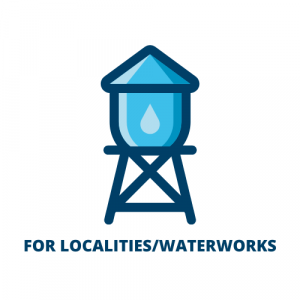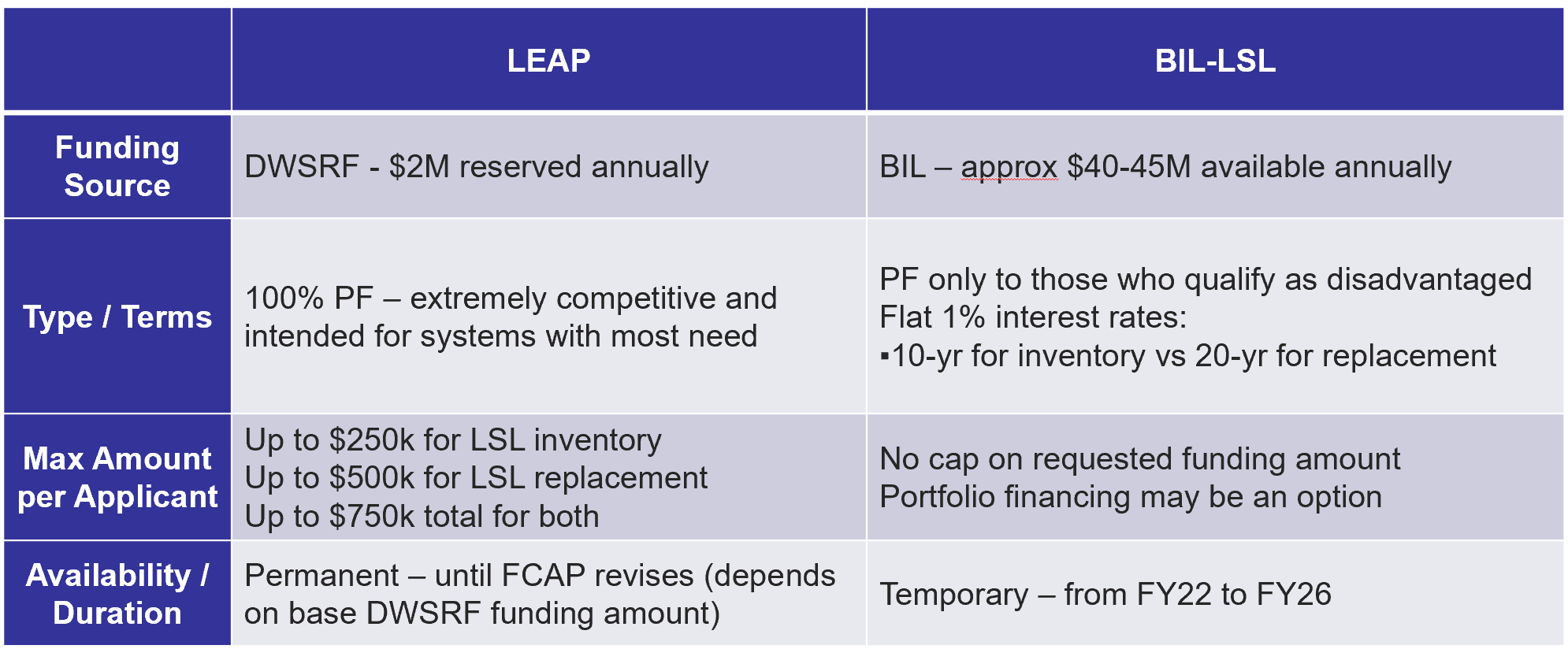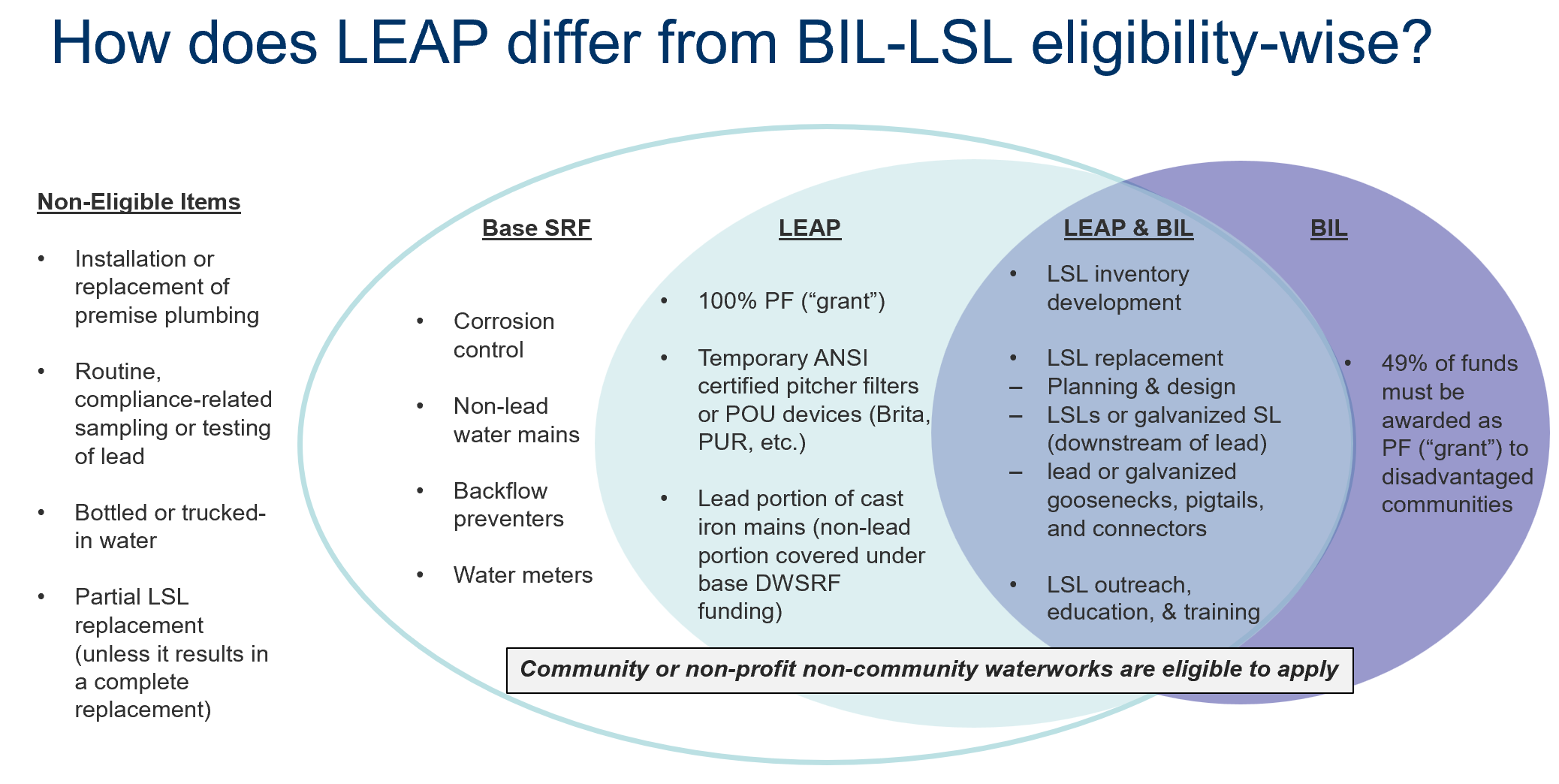
In an effort to accelerate the removal of lead in drinking water, the DWSRF Program has made funding available for the complete removal of the public and/or private portions of lead service lines (LSLs). Funding is set aside annually from the core DWSRF Program for the Lead Elimination Assistance Program (LEAP). These funds are awarded as 100% principal forgiveness (grant) and may be used for both building an LSL inventory and LSL replacement work. Funding covers pipe entry into the structure (up to shut off valve) but excludes the premise plumbing. For more detailed information, please view our LEAP flyer below.
New for FY2022 through FY2026: Additional funding for LSL projects is now available through the Bipartisan Infrastructure Law (BIL), also known as the Infrastructure Investment and Jobs Act (IIJA). These funds may be awarded as principal forgiveness (grant), loan, or a blend of both. You may apply for both LEAP and BIL-LSL funding in a single LEAP application. Please refer to the FAQ section below for more details.
Application and Guidance
The Lead Elimination Assistance Program (LEAP) Application and LEAP Application Instructions are available to download below. Note: If the scope of your potential project will include other construction work in addition to LSL work, such as water main replacement or meter installation, you will be required to submit a separate Construction Funds Application in addition to the LEAP Application.
Templates for the LSL Inventory and LSL Replacement Plan may be found under LCRR Guidance. Procedural Guidelines contain information on our programmatic requirements such as MBE/WBE, Davis-Bacon, and AIS/BABA. Appendix D of the Program Design Manual and the Scorecard explain how LSL projects are ranked and scored.
Deadlines and Submittal Information
Please refer to the dates below to ensure that your LEAP Application is submitted before the deadline. You may submit your application via email using the instructions below:
- Please send to LEAP.applications@vdh.virginia.gov
- With the subject line FY25 LEAP Application - City/County - Project Name
If files are too large and exceed email file limits, it is acceptable to send multiple emails with your application and attachments. Alternatively, you may send a Google Drive link (or similar platform) to share access to your application documents. Please note that, unfortunately, applications submitted via Dropbox can no longer be accepted. VDH has blocked Dropbox due to the fact that it does not meet the Agency's security standards. If you have not received a confirmation email that your application has been received within 2 business days of application submittal, please contact one of our Project Managers in our FCAP Directory.
LSL Inventory Projects
- The last chance to request funding for LSL Inventory work is March 31, 2024.
- After this deadline, all inventory projects must have an associated replacement plan.
LSL Replacement Projects
- The required Funding Application Discussion Meeting must be held prior to submitting your application.
- Applications may be submitted year-round, but will only be reviewed once a year. The next review period is anticipated to be May 2024.
Frequently Asked Questions - for Localities and Waterworks
Click on each bar below to expand and view the answers to frequently asked questions.
The Lead Elimination Assistance Program (LEAP) is a subset of VDH-ODW's regular Drinking Water State Revolving Funds (DWSRF) Program. Each year, $2M of the Capitalization Grant is dedicated for use in LEAP. These dedicated LEAP funds are 100% principal forgiveness (grant funds).
LEAP funding is to be used exclusively for work that involves lead removal. If you have a project that involves both lead and non-lead work, you will need to complete both the LEAP Application and the Construction Funds Application.
Please note that since LEAP utilizes DWSRF funding, all LEAP projects will need to follow the same programmatic, State, and Federal requirements that are required for other Construction Projects, unless otherwise stated. Certain requirements may be deemed not applicable to LEAP projects, depending on the scope and setup of the project. These non-applicable items will be determined after all potential LEAP projects once all applications have been received and evaluated.
Yes! - One of the 3 categories under the Bipartisan Infrastructure Law (BIL) funding is specifically allotted for LSL work. This pot of funding covers both LSL Replacement as well as LSL Inventory work. Approximately $45M specifically for BIL-LSL funding will be available each year, from FY 2022 through FY 2026. This BIL-LSL funding is intended to supplement the LEAP funding. In general, LEAP funding is awarded as 100% principal forgiveness (grant), while BIL-LSL funding also has some grant funding available but may contain a loan portion. In addition, LEAP eligibility is slightly more flexible compared to BIL-LSL eligibility.
The main difference between LEAP funding and BIL-LSL funding is the amount of funding you can request in your LEAP application. Since LEAP is 100% principal forgiveness, the funding is intended for systems with the most need. With LEAP, you may apply for a maximum amount of: up to $250,000 for LSL inventory work and up to $500,000 for LSL replacement work (for a total of up to $750,000 for both). With BIL-LSL, there is no cap on the requested funding amount. If it is anticipated that the project is large enough to be carried out in phases, portfolio financing may be an option. In addition, LEAP funding is permanent (depending on the base DWSRF funding amount), while BIL-LSL funding is temporary from FY 2022 through FY 2026. Please see the table below for details:

In general, LEAP funding is slightly more flexible compared to BIL-LSL funding. Both community or non-profit non-community waterworks are eligible to apply. Please also note that both sources of funding do not cover premise plumbing fixtures such as sinks, toilets, etc. The funds cannot be used inside the structure, beyond tying into the structural plumbing. The chart below provides a more detailed overview of eligible versus non-eligible items:

The Virginia Department of Health, Office of Drinking Water (VDH-ODW) maintains primary enforcement responsibility (primacy) under the SDWA (Safe Drinking Water Act) and the federal SDWA regulations for the Commonwealth of Virginia. As the primacy agency, the VDH-ODW will be implementing the Lead and Copper Rule Revision (LCRR) requirements. Please check the VDH-ODW Lead and Copper Rule Revisions (LCRR) Guidance webpage for the latest information, including templates, training information, and FAQ documents.
If you have any further questions, please submit an email to LEAP.applications@vdh.virginia.gov or use the Contact Us form below.
